I have just returned from my first 10-day expedition to the mountains of southeast Idaho where I study the Northern Goshawk. Northern Goshawks are forest raptors (accipiters) that are found across the world in forested or fragmented landscapes, breeding in areas from the United States into Canada and down into a portion of Mexico, across Europe and into Russia and parts of Southeast Asia. Because of their secretive nature and habitat preference, Northern Goshawks can be difficult to come by unless you spend a considerable amount of time in areas with suitable goshawk habitat or are educated and informed of goshawk territories. Few people I have talked to even know of the species, let alone have seen the bird. I had never seen a Northern Goshawk until this project.
My research will focus on the microhabitat preferences of breeding Northern Goshawks–what habitat characteristics lead a goshawk to choose a specific nest site? I will be collecting variables such as tree density, canopy cover, diameter of trees, tree height, crown depth, and distance to edge. With this research, I hope to develop a habitat model that can be presented to the Forest Service and used to maintain the forest in a way that is conducive to goshawk occupancy and breeding. The Sawtooth National Forest is a multi-use forest, in which grazing, logging, and recreational activities take place regularly. For this reason, the landscape is always changing, and the goshawk population may be affected. Rob Miller, raptor biologist and my mentor, is studying turnover rates, which will indicate the stability of the population. For example, if adult females are being replaced in the territories that they previously occupied at relatively high rates, whether it is because they are dying or moving to different areas to breed, the population may be unstable.
The first Northern Goshawk I saw was perched quietly on a dead branch below the canopy of a douglas fir about 50 meters from us. We were approaching a historical nest site in the Albion Mountains and Rob spotted her silhouette between the trees. Her back was to us, but her head was turned to watch us. She kept silent as we walked up to her nest. In the nest, she had two 10-14 day old nestlings. Through my binoculars, I could make out two fuzzy white heads with little black eyes. Even as we were collecting habitat data, the female did not sound an alarm call and was extremely docile. Rob made sure I knew that most females would not be this calm.
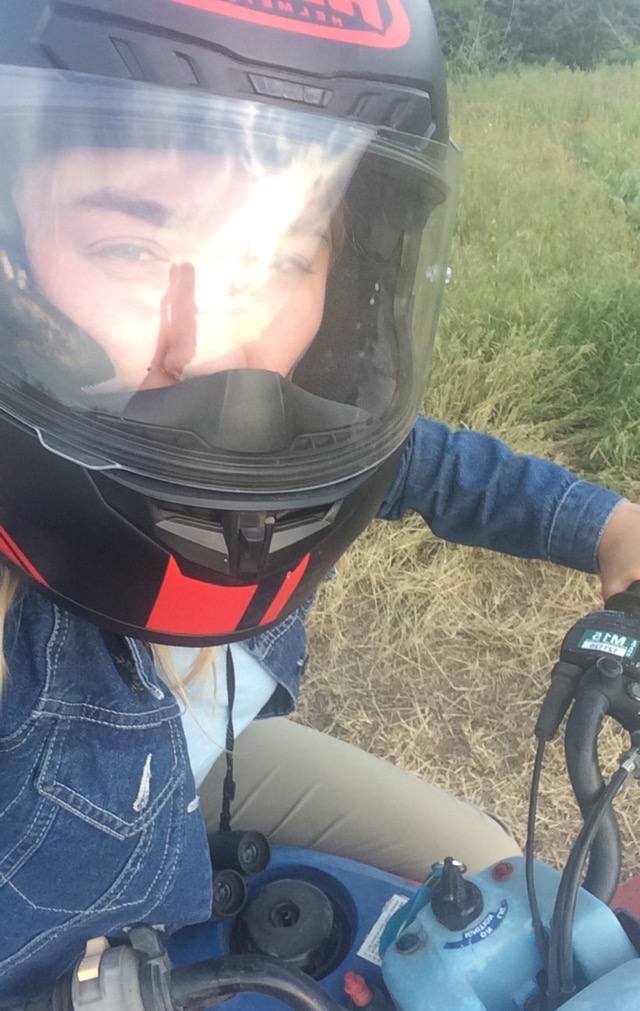
The next known goshawk territory that we visited, also in the Albion Mountains, provided a first glimpse at a more defensive female. Rob and I were walking through a particularly good-looking stand (good for goshawks!) when we heard the kak-kak alarm call. She approached us screaming loudly and landed in the top of a large douglas fir, watching us. There had not been documentation of a nest in this particular area, and we had to interpret her behavior to locate the nest. We moved through the tree stand in different directions to see whether the female would respond with aggressiveness. If her behavior escalated, we knew we were getting closer to the nest. We found two 10-14 day old nestlings in her nest. Success!
Next, we moved on to the Subletts…
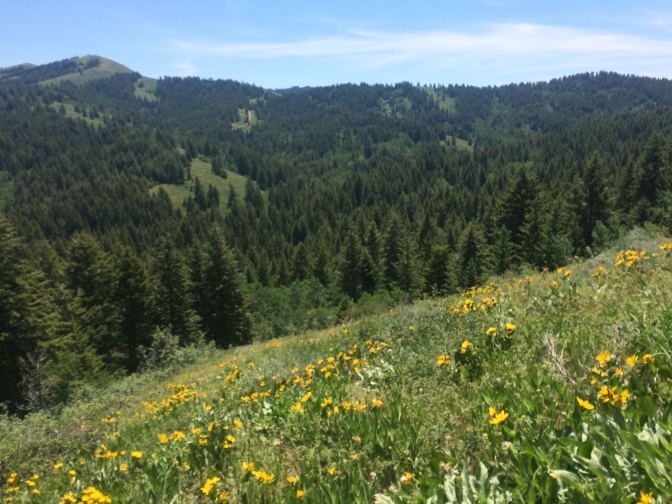
I spent the next two days searching for Northern Goshawks in potential territories. I performed broadcast surveys, playing recordings of alarm calls at points 300 meters away from each other in an attempt to awaken the territorial and protective instinct in an angry goshawk. This part of the job requires great amounts of hiking off-trail, up and down mountains and through thick patches of brush. By the end of my 10 days, I had put 80-90 miles of hiking behind me.
Unfortunately, the population of goshawks in the Sublett Mountains this year seems to be lacking compared to previous years. The only occupied nest we found in the Subletts was located by Rob. On a day when we had a large crew of volunteers to help, we set out to trap the female. We placed a stuffed Great-Horned Owl in front of the Dho-Gazza net. Northern Goshawks and Great-Horned Owls are sworn enemies–they raid each others’ nests; thus, a goshawk will dive down to attack the owl, flying into the net (hopefully), which will then collapse on the bird. The stuffed owl we use has fishing line attached to his wings that we can pull to make him move. His head is a bit unstable (it is Velcro-ed on to the rest of his body and frequently falls off–he resembles a bobblehead). The people at the trapping site hide under camouflage tarps and blankets on either side of the net and must remain perfectly still and quiet. At this site, I was in charge of playing owl calls to bring the female in to defend her nest. It took a while, but after taking the owl’s head off and almost diving into one of the volunteers (Michelle), the female goshawk dove down one last time at the right angle, and hit the net.
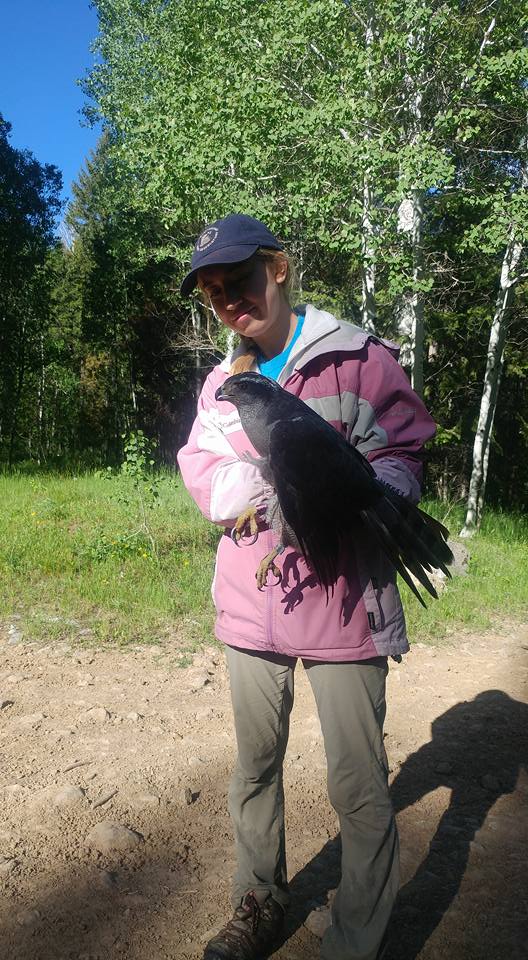
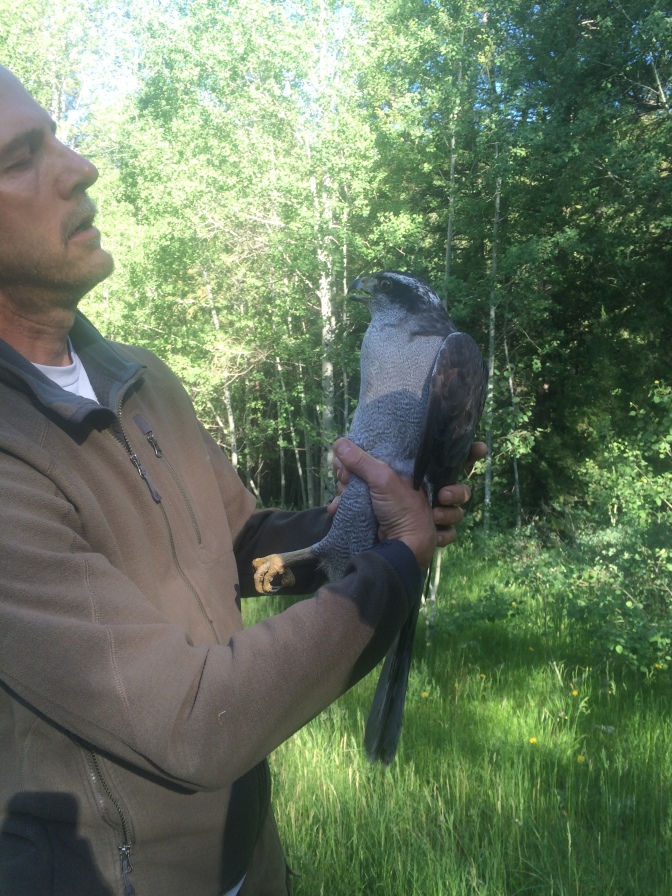
Watching the powerful mother goshawk dive onto the owl was a crazy, intense, incredible experience. The fact that she continued to attack the owl after she took its head off was hilarious. Holding her was even more fascinating. I had to be firm in my grasp because her legs and wings were very strong, and her talons were always ready to dig into my arm. What a beautiful and awesome bird.
While we were camped at the Mill Flat Campground in the Sublett Range, a male goshawk hunted ground squirrels in the clearing of sagebrush and grasses across the road. We watched him dive quietly, rapidly, out of the trees behind our campsite, across the road, and crash into his prey. We believe he may be the mate of the female we banded.
Of course, living in the mountains, I encountered so much more wildlife in addition to raptors. One evening, as I was getting ready to turn in for the night, I was being serenated by a Common Poorwill cooting softly somewhere in the nearby forest. Two Great-Horned Owls were calling to one another. First, one with a low pitch. A slightly higher pitched series of hoots would answer. Across the road, a large dark figure appeared in my vision. At first I thought it was simply part of the landscape or a wooden sign. But the figure moved, taking a few steps up the hillside before turning around and staring at me. I took two steps towards it, and the animal began walking slowly across the hillside. I knew right when I saw its profile–moose! A few days later, while doing broadcast surveys, I came across another moose in the forest.
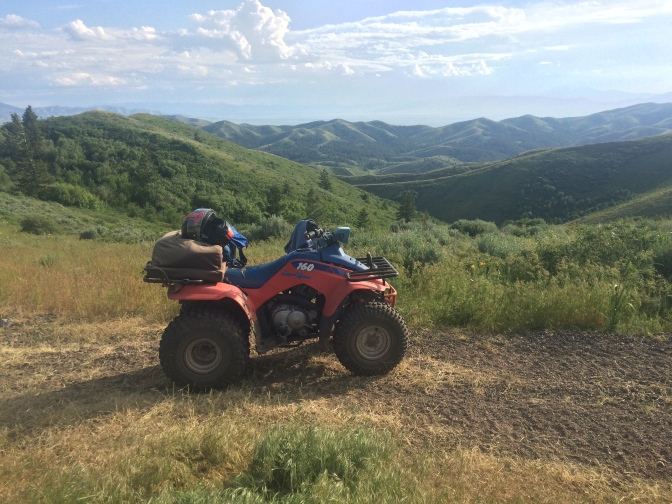
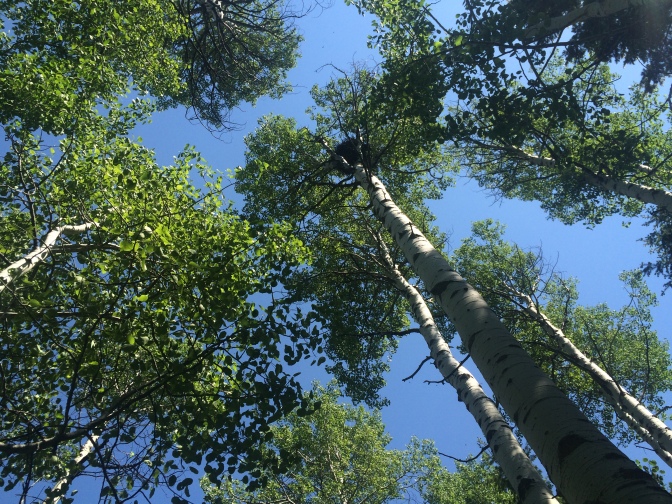
After completing our search of the Sublett Range, we went back to search two more territories in the Albions…
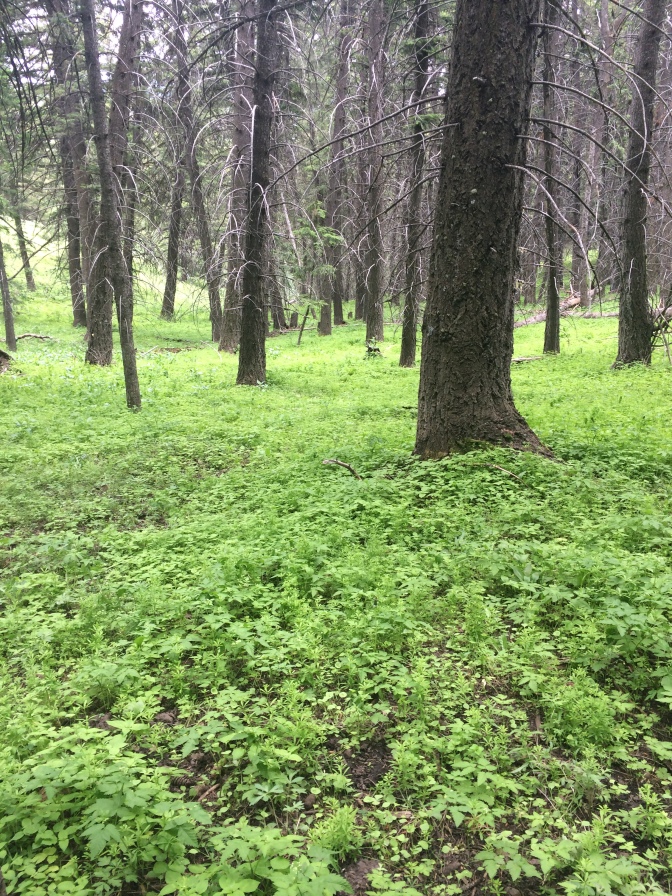
While searching the above stand for the historical nest that we found to be no longer viable, Rosemary and I startled a Great-Horned Owl, which flew from her roost and quietly perched on a branch where she could watch us. I stared back at her shockingly yellow eyes through my binoculars, and watched her spin her head around. We concluded that she probably had a nest nearby since she did not venture far from her original spot.
The next territory we found occupied, and the female was fairly aggressive. She had two young nestlings (also 10-14 days old). We attempted to trap her but were unsuccessful since her flight path seemed to be (for the most part) directly parallel to the net. I did get a great view of the bird as she dove down to attack the owl and flew right above my spot under a tarp several times. Rob later asked me why I ducked…
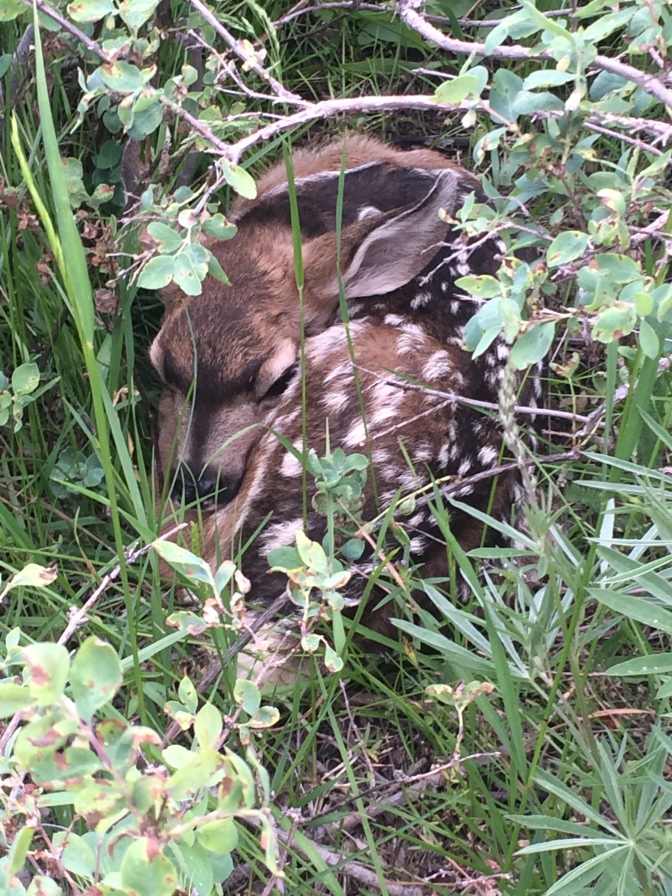
Along with this little fawn, we saw a group of male elk with fuzzy antlers walking along the ridge above where we were camped in the Albions. There were at least six of them, and I watched as each took a few steps and stared down at us before continuing.
After finishing up in the Albion Mountains, we headed to the Raft River Range, which extends into Utah.
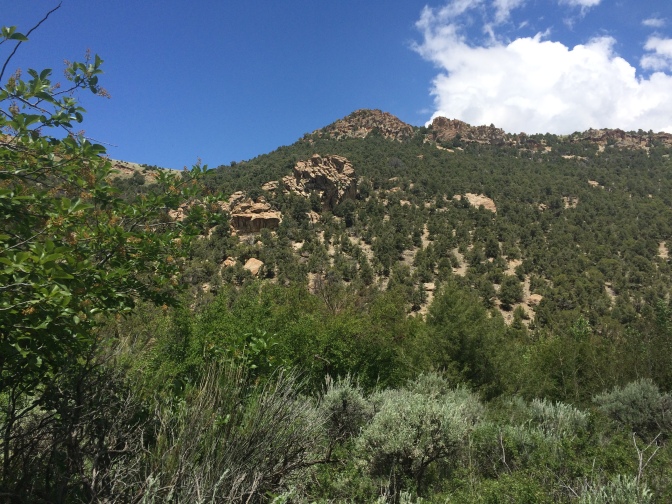
One goshawk territory that we visited (in which we found an occupied nest) in the Raft River division was a bit of an anomaly habitat-wise. Most of the territories we surveyed during these 10 days were dominated by douglas fir or mixed douglas fir/aspen stands. This territory was dominated by piñon pine and juniper. The habitat characteristics in this nest site (especially tree height and canopy cover) were vastly different from those of the eight other occupied nest sites we found this time around.
As we approached the historical nest site of this territory, we saw three 30-35 day old nestlings–much older than any other nestlings I’d seen so far.
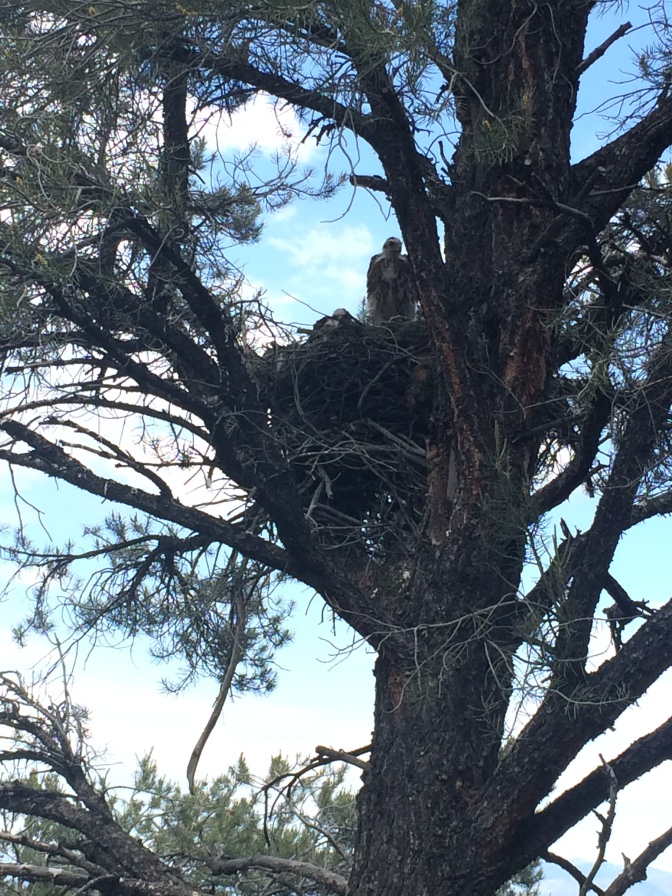
As Rob made his way up this tree to retrieve the nestlings for banding, the largest and most daring of them (likely the one standing in the nest in the above picture) decided she would take her first flight. She flew (a little clumsily) down to the ground and landed about 10 meters from the nest. I quickly ran over to her, and as I approached, the juvenile bird who had reached adult size stretched out her wings and tail and glared at me in an attempt to look vicious. For a second I hesitated. I knew the power in the talons of an adult goshawk and was not sure if I would be able to pick her up. I cautiously reached behind the nestling and grasped her legs as I would an adult bird. No struggle, no kicking or flapping–just a look of utter confusion from the (now) fledgling. I took her over to the banding kit, put a colored band on her right leg and a silver on her left, and she was sent back up to Rob in a cloth bag and returned to the nest. I will never forget my first nestling goshawk, color band code AM. I hope someday she is resighted on a nest of her own!
The smallest bird in the nest was lowered down the tree in a cloth bag by Rob, and as I took the nestling out of the bag, he/she was already displaying more of a ferocious demeanor, attempting to foot me with its talons and flapping its wings. We were not able to determine with certainty the sex of the bird, since it was likely behind in development from its sibling, and Rob was not at the base of the tree to make the call, but we have a suspicion that it is a male due to its smaller size. A photoshoot was needed to capture the personality and cuteness…
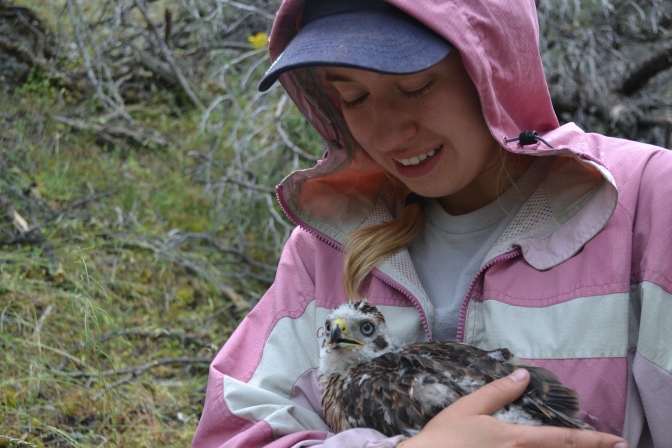
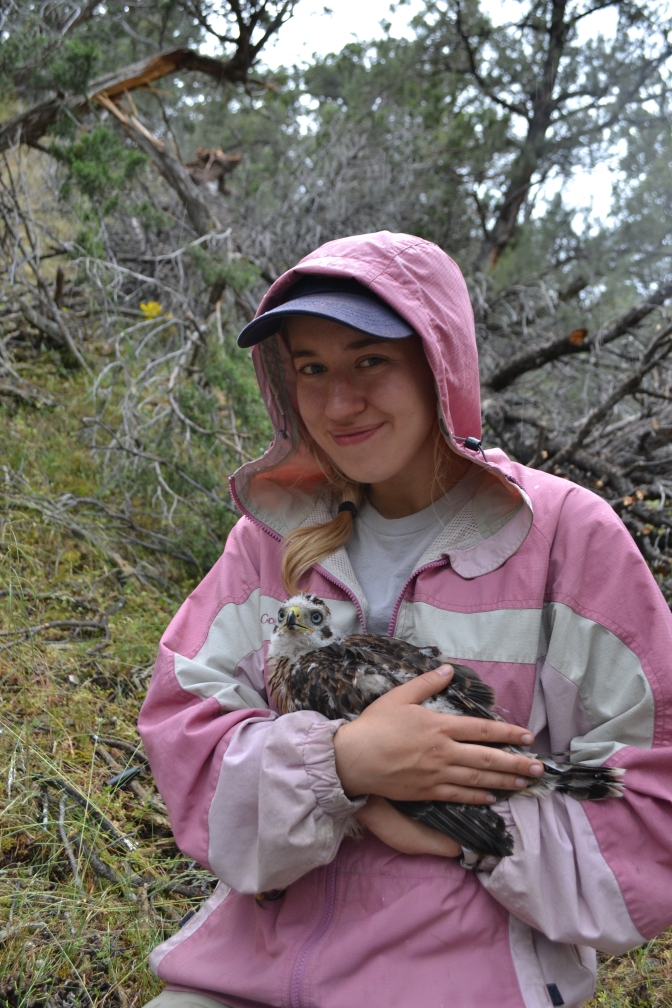
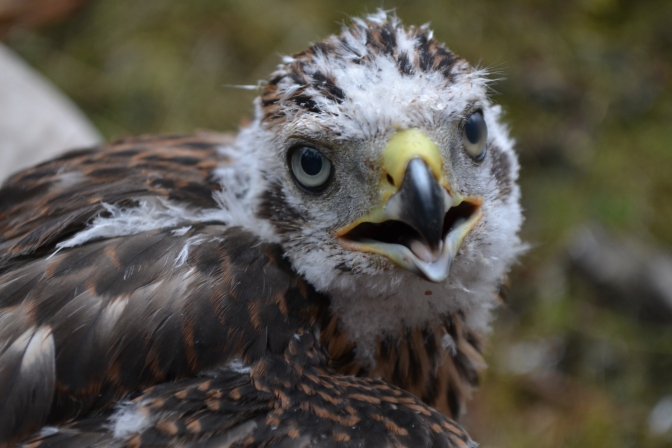
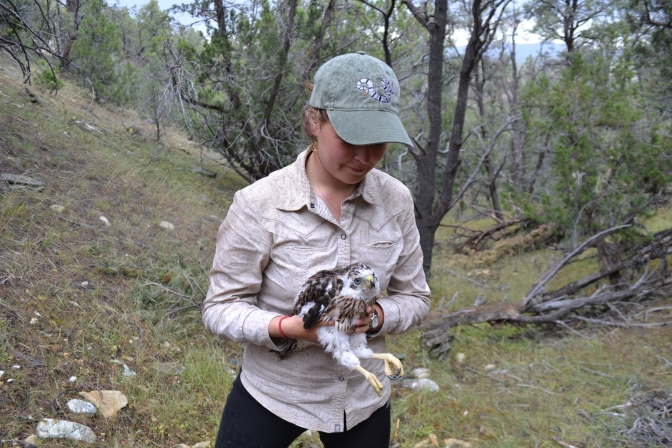
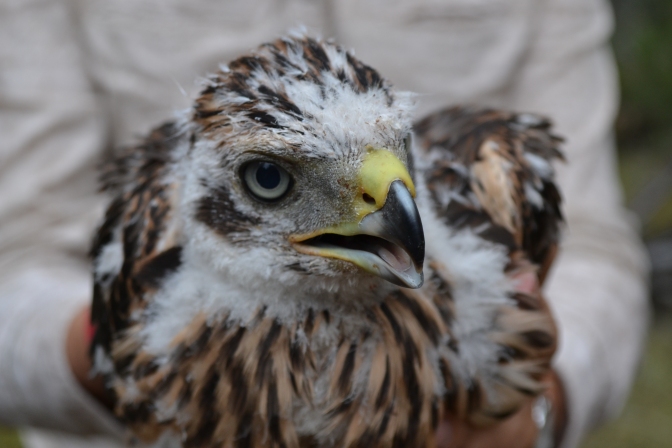
Rob was unable to reach the third nestling while he was in the tree because she had walked out onto a branch away from the nest. So after we returned the first two nestlings to the nest, we left the territory.
We finished up the Raft River and Black Pines divisions, finding several more nests. We did not trap or climb into any more nests.
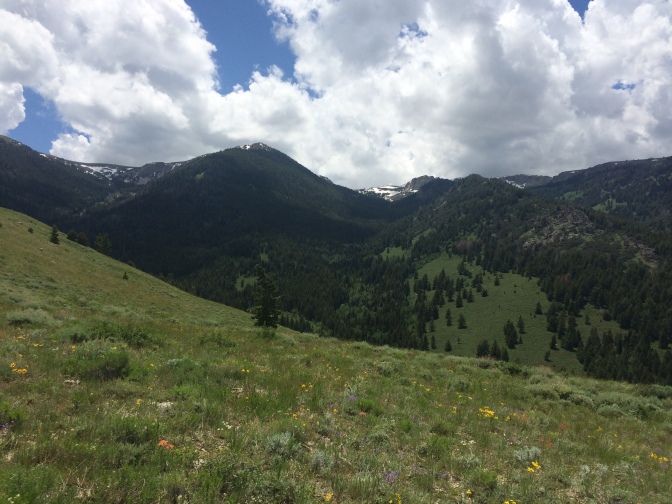
Searching for goshawks in the above terrain was very physically draining, as the elevation changes were fairly large to reach some call points. Whenever I am out alone doing broadcast surveys, I am always fascinated by everything that I see. Deer stare me down before thumping away, turkey vultures and Red-tailed Hawks circle above me, and animal scat and tracks are all over the woods (I may have seen Mountain Lion tracks at one point!!). I saw several lifer birds (I’d never seen before), including Green-tailed Towhees, Black-throated Gray Warblers, and Juniper Titmice.
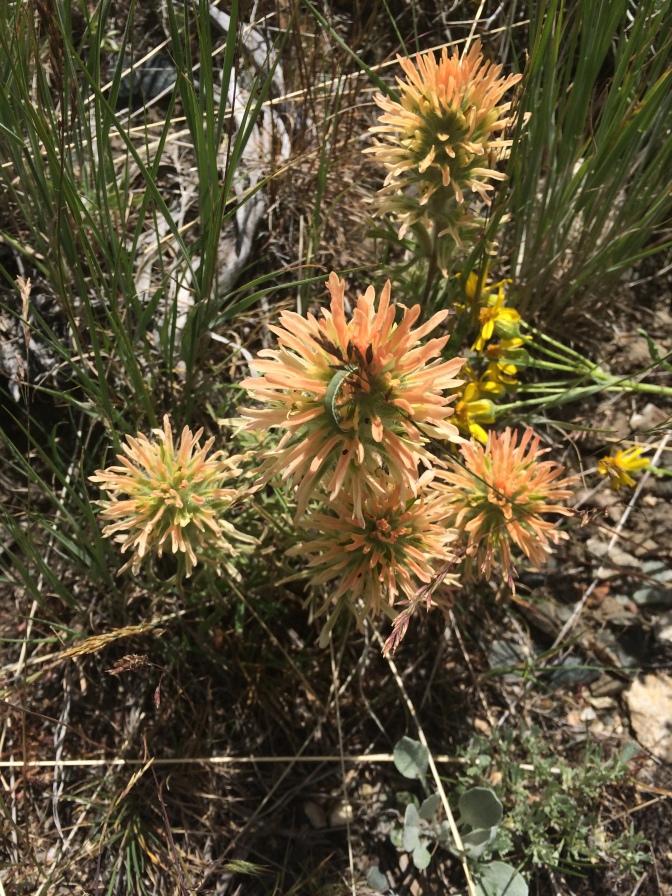
On our last day, Rob and I traveled to the City of Rocks to check out a reported nest there. Unfortunately, the nest had already failed by the time we got there, likely due to human disturbance. The stress on the mother may have caused her to leave her young alone and vulnerable to predators. While we were there, I caught a glimpse of Cliff Swallows and White-Throated Swifts swarming around the rocks and diving in and out of crevices. There always seems to be something amazing to see.
My first experience with field work was incredible. In the past 10 days, I have not only gotten physically stronger (my legs are ready for anything now), but I have learned so much from my mentor Rob and just from observing Northern Goshawks firsthand. I cannot wait to get back out there.
Most of the trapping and tree climbing I will witness or participate in will be happening in the upcoming week, when I go back out into the field for 10 days to the South Hills. The bulk of our data will come out of this division, since it hosts the most known goshawk territories. Be prepared for many more pictures next time!
It’s so thrilling to read about your adventure!
LikeLike
So fun to read! See you next week!
LikeLike
https://raptorresearchcenter.boisestate.edu/hasselblad-kristin-northern-goshawk-home-ranges-and-habitat-selection-in-southern-idaho/
LikeLike
Here’s this! https://raptorresearchcenter.boisestate.edu/hasselblad-kristin-northern-goshawk-home-ranges-and-habitat-selection-in-southern-idaho/
LikeLike
Whoops clearly I am not good as Wordpessing!
LikeLike